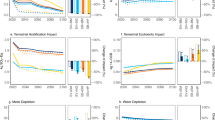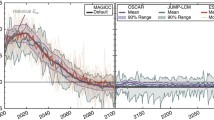Abstract
It is physically possible to capture CO2 directly from the air and immobilize it in geological structures. Air capture differs from conventional mitigation in three key aspects. First, it removes emissions from any part of the economy with equal ease or difficulty, so its cost provides an absolute cap on the cost of mitigation. Second, it permits reduction in concentrations faster than the natural carbon cycle: the effects of irreversibility are thus partly alleviated. Third, because it is weakly coupled to existing energy infrastructure, air capture may offer stronger economies of scale and smaller adjustment costs than the more conventional mitigation technologies.
We assess the ultimate physical limits on the amount of energy and land required for air capture and describe two systems that might achieve air capture at prices under 200 and 500 $/tC using current technology.
Like geoengineering, air capture limits the cost of a worst-case climate scenario. In an optimal sequential decision framework with uncertainty, existence of air capture decreases the need for near-term precautionary abatement. The long-term effect is the opposite; assuming that marginal costs of mitigation decrease with time while marginal climate change damages increase, then air capture increases long-run abatement. Air capture produces an environmental Kuznets curve, in which concentrations are returned to preindustrial levels.
Similar content being viewed by others
References
Anderson, D. and Cavendish, W.: 2001, ‘Dynamic simulation and environmental policy analysis: Beyond comparative statistics and the environmental Kuznets curve,’ Oxford Economic Papers 53(4), 721–746.
Audus, H.: 2004, ‘Climate change mitigation by biomass gasification combined with CO2 capture and storage,’ in Proceedings of 7th International Conference on Greenhouse Gas Control Technologies, Volume 1: Peer-Reviewed Papers and Plenary Presentations, Cheltenham, UK, IEA Greenhouse Gas Programme.
Borghesi, S.: 1999, The environmental Kuznets curve: A survey of the literature. Technical Report Nota do lavoro 85.99, Fondazione Eni Enrico Mattei, URL http://www.feem.it/web/resun/wp/85-99.html.
Elliott, S., Lackner, K. S., Ziock, H. J., Dubey, M. K., Hanson, H. P., Barr, S., Ciszkowski, N. A., and Blake, D. R.: 2001, ‘Compensation of atmospheric CO2 buildup through engineered chemical sinkage,’ Geophysical Research Letters 28(7), 1235–1238.
Flanagan, P.: 2004, Email conversation. Associated with Groupe Laperrire and Verreault.
Greenwood, K. and Pearce, M.: 1953, ‘The removal of carbon dioxide from atmospheric air by scrubbing with caustic soda in packed towers,’ Transactions of the Institution of Chemical Engineers 31, 201–207.
Grübler, A., Nakićenović, N., and Victor, D. G.: 1999, ‘Dynamics of energy technology and global change,’ Energy Policy 27, 247–280.
Ha-Duong, M., Grubb, M. J., and Hourcade, J.-C.: 1997, ‘Influence of socioeconomic inertia and uncertainty on optimal CO2-emission abatement,’ Nature 390, 270–274. URL file://HaDuong.ea-1997-InfluenceInertiaUncertaintyAbatement.pdf.
Herzog, H., Caldeira, K., and Reilly, J.: 2003, ‘An issue of permanence: Assessing the effectiveness of temporary carbon storage,’ Climatic Change 59.
Hoftyzer, P. J. and van Krevelen, D. W.: 1954, ‘Applicability of the results of small-scale experiments to the design of technical apparatus for gas absorption,’ Transactions of the Institution of Chemical Engineers, Supplement (Proceedings of the Symposium on Gas Absorption 32, S60–S67.
IPCC: 1997, Stabilisation of Atmospheric Greenhouse Gases: Physical, Biological and Socio-economic Implications (IPCC Technical paper III). UNEP/WMO. Working Group I.
IPCC: 2001, Climate Change 2001: Mitigation. Cambridge University Press.
Johnston, N. A. C., Blake, D. R., Rowland, F. S., Elliott, S., Lackner, K. S., Ziock, H. J., Dubey, M. K., Hanson, H. P., and Barr, S.: 2003, ‘Chemical transport modeling of potential atmospheric CO2 sinks,’ Energy Conversion and Management 44(5), 683–691.
Keith, D. W.: 2000, ‘Geoengineering the climate: History and prospect,’ Annual Review of Energy and the Environment 25, 245–284.
Keith, D. W.: 2001, ‘Sinks, energy crops, and land use: Coherent climate policy demands an integrated analysis of biomass,’ Climatic Change 49, 1–10.
Keith, D. W. and Farrell, A. E.: 2003, ‘Rethinking hydrogen cars,’ Science 315–316.
Keller, K., Yang, Z., and Hall, M.: 2003, Carbon dioxide sequestration: When and how much? Working Paper Series 84, Princeton University, Center for Economic Policy Studies, In revision for Climate Change.
McFarland, J. R., Reilly, J. M., and Herzog, H.J.: 2004, ‘Representing energy technologies in top-down economic models using bottom-up information,’ Energy Economics 26, 685–707.
Metzger, R. A. and Benford, G.: 2001, ‘Sequestering of atmospheric carbon through permanent disposal of crop residue,’ Climatic Change 49, 11–19.
M'ollerstena, K., Yana, J., and Moreirab, J. R.: 2003, ‘Potential market niches for biomass energy with CO2 capture and storage – opportunities for energy supply with negative CO2 emissions,’ Biomass and Bioenergy 25, 273–285.
National Academy of Science NAS: 2002, Abrupt climate change: Inevitable surprises. National Academy Press, Washington, D.C.. ISBN 0-309-07434-7.
Nordhaus, W. D.: 2002, ‘Modeling induced innovation in climate-change policy,’ in Grübler, A., Nakicenovic, N., and Nordhaus, W. D. (eds.), Technological Change and the Environment (Chap. 8), Resources for the Future, pp. 182–209.
Obersteiner, M., Azar, C., Kauppi, P., Möllersten, K., Moreira, J., Nilsson, S., Read, P., Riahi, K., Schlamadinger, B., Yamagata, Y., Yan, J., and van Ypersele, J.-P.: 2001, ‘Managing climate risk,’ Science 294(5543), 786–787.
Rao, A. B.: 2004, Personal communication.
Rao, A. B. and Rubin, E. S.: 2002, ‘A technical, economic, and environmental assessment of amine-based CO2 capture technology for power plant greenhouse gas control,’ Environmental Science and Technology 36(20), 4467–4475.
Reimer, P., Eliassed, B. et al. (eds.): 1999, Greenhouse Gas control Technologies: Proceedings of the 4th International Conference, Interlaken, Switzerland, Pergamon.
Rhodes, J. S. and Keith, D. W.: 2005, ‘Engineering-economic analysis of biomass IGCC with carbon capture and storage,’ Biomass and Bioenergy 29, 440–450.
Stolaroff, J. K., Lowry, G. V., and Keith, D. W.: 2005, ‘Using CaO- and MgO-rich industrial waste streams for carbon sequestration,’ Energy Conversion and Management 46(5), 687–699.
Weast, R. C. (ed.): 2003, CRC Handbook of Chemistry and Physics. CRC Press, Boca Raton, FL.
Willams, D., Durie, B., McMullan, P., Paulson, C., and Smith, A. (eds.): 2001, Greenhouse Gas Control Technologies: Proceedings of the 5th International Conference on Greenhouse Gas Control Technologies, Collingwood, Australia. CSIRO Publishing.
Zeman, F. S. and Lackner, K. S.: 2004, ‘Capturing carbon dioxide directly from the atmosphere,’ World Resources Review 16, 62–68.
Author information
Authors and Affiliations
Corresponding author
Rights and permissions
About this article
Cite this article
Keith, D.W., Ha-Duong, M. & Stolaroff, J.K. Climate Strategy with Co2 Capture from the Air. Climatic Change 74, 17–45 (2006). https://doi.org/10.1007/s10584-005-9026-x
Received:
Revised:
Accepted:
Published:
Issue Date:
DOI: https://doi.org/10.1007/s10584-005-9026-x




